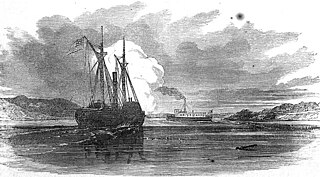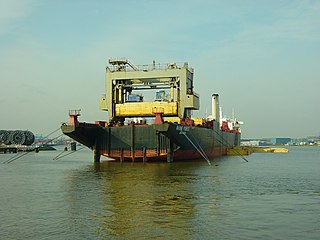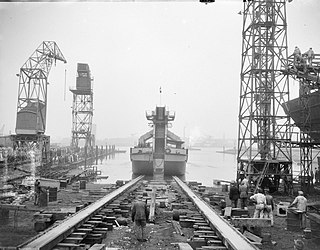
A tugboat or tug is a marine vessel that manoeuvres other vessels by pushing or pulling them, with direct contact or a tow line. These boats typically tug ships in circumstances where they cannot or should not move under their own power, such as in crowded harbors or narrow canals, or cannot move at all, such as barges, disabled ships, log rafts, or oil platforms. Some are ocean-going, and some are icebreakers or salvage tugs. Early models were powered by steam engines, which were later superseded by diesel engines. Many have deluge gun water jets, which help in firefighting, especially in harbours.

A salvage tug, known also historically as a wrecking tug, is a specialized type of tugboat that is used to rescue ships that are in distress or in danger of sinking, or to salvage ships that have already sunk or run aground.

The lighter aboard ship (LASH) system refers to the practice of loading barges (lighters) aboard a bigger vessel for transport. It was developed in response to a need to transport lighters, a type of unpowered barge, between inland waterways separated by open seas. Lighters are typically towed or pushed around harbors, canals or rivers and cannot be relocated under their own power. The carrier ships are known variously as LASH carriers, barge carriers, kangaroo ships or lighter transport ships.

Empire Sandy is a tall ship providing chartered tours for the public from Toronto, Canada. She was built as an Englishman/Larch Deep Sea-class tugboat for war service by the British government in 1943. After the end of World War II she was renamed Ashford and then Chris M before reverting to the original name of Empire Sandy and being converted to a schooner.
Nedlloyd was a Dutch shipping company, formed in 1970 as the result of a merger of several shipping lines:

Fop Smit was a Dutch naval architect, shipbuilder, and shipowner. He founded the towage and salvage company L. Smit & Co that is now part of Smit International. His shipyard had a number of "firsts" in shipbuilding and produced a number of famous vessels.

An emergency tow vessel, also called emergency towing vessel, (ETV) is a multi purpose boat used by state authorities to tow disabled vessels on high seas in order to prevent dangers to man and environment. The disabled vessel is either towed to a safe haven or kept in place against wind and current until commercial assistance by tug boats has arrived on site or until it has been repaired to the extent of being able to manoeuvre on its own. The need for ETVs as a preventive measure has arisen since the number of available commercial salvage tugs was reduced while potential dangers from individual vessels have increased. E.g. Spain has fourteen, Turkey has eleven, Germany operates eight, Norway has seven, France has five, Sweden three and the Netherlands, Poland, South Africa, Iceland and Finland each have one official emergency tug boat. Australia also operates emergency response vessels. The United Kingdom's four strong ETV fleet was to be disbanded in September 2011 due to budget cuts but the two vessels operating in Scottish waters received an extension of contract until the end of 2011.

Noordereiland is a neighborhood of Rotterdam, Netherlands. The Noordereiland owes its name to the Noorderhaven which, under the leadership of C.B. van der Tak was dug between 1872 and 1874. By digging the Noorderhaven, the Noordereiland was separated from the former island of Fijenoord and is now an island between the central parts of the North and South side of the city. Until the end of the 20th century the island was inhabited by a large population of inland skippers. Part of the neighborhood is a protected cityscape.

Mayflower is a steam tug built in Bristol in 1861 and now preserved by Bristol Museums Galleries & Archives. She is based in Bristol Harbour at M Shed. She is the oldest Bristol-built ship afloat, and is believed to be the oldest surviving tug in the world.
Van der Schuyt, Van den Boom en Stanfries NV, or S.B.S. NV was a Dutch transport company. It was founded in 1948 in a period of change, when shipping companies were becoming trucking companies. It was a merger of three of the biggest inland shipping companies, originally offering scheduled and combined services for passengers, livestock and freight:

The Koninklijke Nederlandse Stoomboot-Maatschappij (KNSM) was an Amsterdam-based shipping company that existed from 1856 to 1981. It was once the largest company in Amsterdam and one of the top five shipping lines in the Netherlands. The company operated mid-sized freighters that had limited passenger accommodations. At its peak in 1939, the company had 79 vessels. Of these, 48 were lost during World War II.

The Type V ship is a United States Maritime Commission (MARCOM) designation for World War II tugboats. Type V was used in World War II, Korean War, and the Vietnam War. Type V ships were used to move ships and barges. Type V tugboats were made of either steel or wood hulls. There were four types of tugboats ordered for World War II. The largest type V design was the sea worthy 186-foot (57 m) long steel hull, V4-M-A1. The V4-M-A1 design was used by a number of manufacturers; a total of 49 were built. A smaller steel hull tugboat was the 94-foot (29 m) V2-ME-A1; 26 were built. The largest wooden hull was the 148-foot (45 m) V3-S-AH2, of which 14 were built. The smaller wooden hull was the 58-foot (18 m) V2-M-AL1, which 35 were built. Most V2-M-AL1 tugboats were sent to the United Kingdom for the war efforts under the lend-lease act. The Type V tugs served across the globe during World War II including: Pacific War, European theatre, and in the United States. SS Farallon, and other Type V tugs, were used to help built Normandy ports, including Mulberry harbour, on D-Day, 6 June 1944, and made nine round trips to Normandy to deliver Phoenix breakwaters.

Fijenoord was a shipbuilding company and machine factory in Rotterdam the Netherlands from 1823 to 1929. In 1929 it merged with Wilton to become Wilton-Fijenoord.

Burgerhout was a Dutch company in Rotterdam, active from 1852 to 1932. In 1865 it became a machine factory. In 1909 it started to build ships and in 1927 it branched out to the aircraft industry.

J. & K. Smit was a Dutch shipbuilding company located in Kinderdijk and Krimpen aan de Lek. Its successor is now part of Royal IHC.

Royal Rotterdam Lloyd was a Dutch shipping line that was established in Rotterdam in 1883 as Rotterdamsche Lloyd (RL). It became "Royal Rotterdam Lloyd" in 1947. RL mainly operated scheduled passenger and mail services between Rotterdam and the Dutch East Indies. Its independent existence ended in 1970, when KRL merged with four other Dutch shipping companies to form the Nederlandsche Scheepvaart Unie (NSU). In 1977 NSU became Nedlloyd.

L. Smit en Zoon previously known as Fop Smit, was a Dutch shipbuilding company located in Kinderdijk. Its successor is now part of Royal IHC.

The Nederlandsche Stoomboot Maatschappij ( ), abbreviated as NSM or NSBM, was a Dutch shipping line focused on inland navigation. In the 1820s it was important for the quick introduction of steam power on the Dutch rivers and on the Rhine. NSM owned the major shipbuilding company Fijenoord.

Hercules was a Dutch steam paddle tugboat. She was also the first vessel to effectively use a compound steam engine. In about 1890, a discussion about the invention of the compound steam engine made that Fijenoord brought up the blueprints of Hercules. These proved that Gerhard Moritz Roentgen had invented the compound steam engine.

SS De Batavier, launched in 1827 was an early steamship which served on the Rotterdam to London line of the Nederlandsche Stoomboot Maatschappij (NSM). As such she was in news quite often, but the Batavier also appeared in fiction and non-fiction. The Batavier is the location of a chapter of Thackeray's Vanity Fair.



















